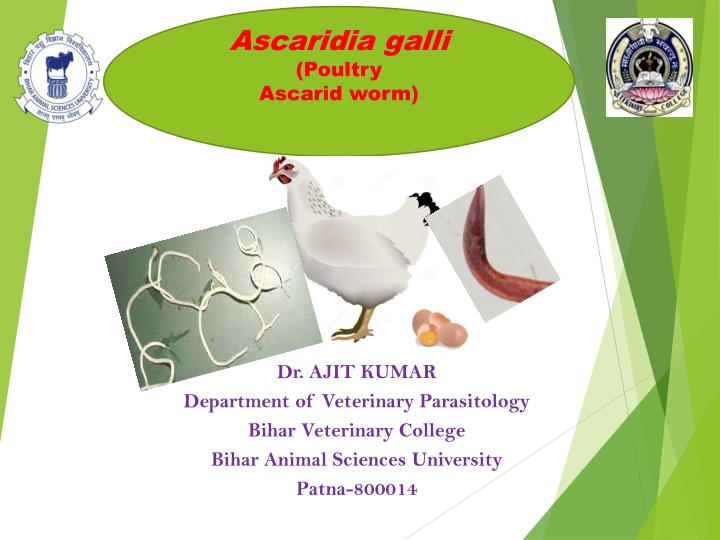
Ascaridia Galli: Poultry Ascarid Worm Information
Learn about Ascaridia galli, a common parasitic worm affecting poultry, including its life cycle, pathogenesis, clinical signs, diagnosis, and treatment. Useful information for poultry farmers and veterinarians.
Download Presentation

Please find below an Image/Link to download the presentation.
The content on the website is provided AS IS for your information and personal use only. It may not be sold, licensed, or shared on other websites without obtaining consent from the author. If you encounter any issues during the download, it is possible that the publisher has removed the file from their server.
You are allowed to download the files provided on this website for personal or commercial use, subject to the condition that they are used lawfully. All files are the property of their respective owners.
The content on the website is provided AS IS for your information and personal use only. It may not be sold, licensed, or shared on other websites without obtaining consent from the author.
E N D
Presentation Transcript
Ascaridia galli (Poultry Ascarid worm) Bihar Animal Sciences University | Dr. AJIT KUMAR Department of Veterinary Parasitology Bihar Veterinary College Bihar Animal Sciences University Patna-800014
Ascaridia galli Final Hosts Final Hosts : Domestic & wild birds : Domestic & wild birds Location: Location: Small Intestine Small Intestine Largest nematode of poultry
Ascaridia galli General Characters: o Males whereas Females are 72- 116 mm long are 50-76 mm o Worms are stout, densely white and oesophagus has no posterior bulb. o Male worm has 10 pairs anal papillae. o Egg is oval with smooth shells
Ascaridia galli Life Life- -cycle cycle: : o Direct life-cycle o Infective containing 2nd stage larvae. stage: egg o Transport host: Earthworm Transmission: Transmission Transmission through 1. I Ingestion of infective egg ngestion of infective egg containing containing L L2 water water 2. Eggs are sometimes ingested by earthworms, which may act as transport host. So, ingestion of earthworm containing L2 larva 1. 2 with food or with food or
Ascaridia galli Pathogenesis: Young birds under twelve weeks of age are more susceptible to infection than adult birds. Highly pathogenic in chickens of 1-3 months of age and chickens over three months of age are more resistant to infection. Dietary deficiency such as those of Vitamin A, B and B12, various minerals and proteins, predispose to heavier infections. Larvae cause catarrhal or haemorrhgaic enteric whereas the adult worms may cause intestinal occlusion and death. Occlusion of Intestine
Ascaridia galli Clinical signs: Worms haemorrhagic enteritis, anaemic, and diarrhoea. cause emaciation
Ascaridia galli Diagnosis : o On the basis of Clinical signs o Microscopic faecal examination o Large adult worms are found in small intestine during necropsy
Ascaridia galli Treatment Piperazine Tetramisole, Phenothiazine, mixture of Phenothiazine and Piperazine are used in the treatment. adipate, Mebendazole,
Ascaridia galli Control: Treatment of infected birds Regular deworming Regular cleaning of floor, feeding and watering utensils etc. Segregation of adult and young birds
THANK YOU
